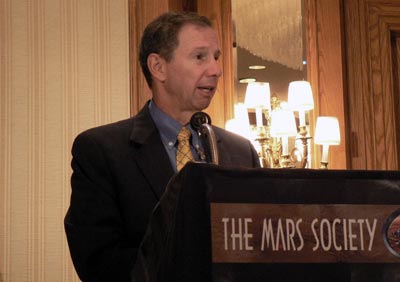Mike Griffin: NASA’s playground supervisor or leading visionary?by Taylor Dinerman
|
| One complaint about the way NASA is structured is the very name of the agency: it’s called an “administration” as if the space program were an established fact that only needed to be administered. |
Before January 2004, when Bush set out his Moon and Mars exploration program, NASA had truly been “Lost in Space”. It was building the International Space Station along with the Russians and with limited help from the Europeans and the Japanese, but it had not launched a single human being beyond Earth orbit since 1972. The usual bureaucratic sclerosis long ago set in, and the spirit of the old Apollo days was long gone. Never again would NASA have annual budgets like the 1965 one, worth over $30 billion in 2006 dollars. The space agency would have to learn to confine its ambitions to those that could be financed with one percent or less of the federal budget, i.e. about 17 to 20 billion dollars.
One complaint about the way NASA is structured is the very name of the agency: it’s called an “administration” as if the space program were an established fact that only needed to be administered. In this role the NASA administrator doesn’t have to lead or to take risks: he or she has only to keep everyone doing exactly what they are supposed to do, sticking to the rules and making sure that everyone plays nice. This is a perfect recipe for going nowhere and spending billions while doing so. It is also a recipe for the kind of cultural failings that were so well described in the Columbia Accident Investigation Board (CAIB) report.
To quote from the CAIB report, “NASA managers believed that the agency had a strong safety culture, but the Board found that the agency had the same conflicting goals that it did before Challenger when schedule concerns, production pressure. cost cutting, and a drive for ever-greater efficiency—all the signs of an ‘operational’ enterprise—had eroded NASA’s ability to assure mission safety.” Rebuilding the safety culture at NASA was a priority and it led to such decisions as the one to cancel the last Hubble servicing mission.
The Vision for Space Exploration (VSE) has upset this culture, and with Mike Griffin in charge NASA may be finally getting out of the business of “administering” space and back in the business of exploration and development. Griffin was lucky to take over at a moment in the history of the US civil space program after a general consensus had been reached that something was profoundly wrong with how the agency had been run in the past. O’Keefe had made a start with his financial and management reforms. His “One NASA” concept may have looked like a cheesy public relations ploy, but everyone knew that there was a serious problem. The centers were running programs that too often failed to fit into the agency’s overall strategy. Whatever their merits, they would all too often be canceled after large sums had been spent on them and before any significant scientific or technological benefit had been obtained.
By organizing the agency around the VSE and Project Constellation, Griffin is changing this. The culture that ran the shuttle and ISS programs as more or less disconnected from NASA’s science and technology development project is almost gone. The complaints that science has been short changed in the FY07 budget are a sign of how deeply this reform hurts. Obviously, in spite of the broad recognition that it is necessary, this new way of doing things has upset a lot of good people.
| Griffin is a man who “gets it” and, more importantly, can convince others that space exploration is the right thing to do, and that the time to do it is now. |
Griffin is not only technically qualified to lead NASA, but at least from the outside, one sees that he has the right people skills as well. Morale cannot be underestimated as an ingredient in any successful organization and NASA’s morale is generally as high as or higher than it ever has been in the last ten or fifteen years. He also has something that no other NASA administrator has ever had: an understanding of venture capital and startup business process. His time as head of In-Tel-Q, the CIA’s entrepreneurial technology fund, has given him an understanding of the way that risk capital and risk-taking businessmen work together. His gamble on the Commercial Orbital Transportation Services (COTS) contract and his support for the NASA prizes is evidence that he understands the way the dynamic new economy works.
He also understands why going back to the Moon and building a base there is important. In a speech last month at NASA Langley he said, “But one assumption that I know will be justified is that the Moon, the near-Earth asteroids, and the rest of the solar system contain the resources that will take mankind to the next level of civilization and prosperity. I don’t know when it will occur or who will do it but it will happen.” This is a man who “gets it” and, more importantly, can convince others that space exploration is the right thing to do, and that the time to do it is now.
It just may be that Mike Griffin is the best administrator NASA has ever had. The hard question, though, is will that be enough? Will he be able to reform the agency and keep the support of his masters in the White House, on Capitol Hill, and, ultimately, throughout America?
